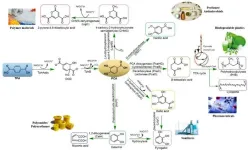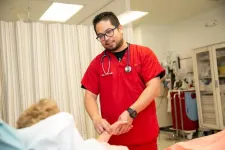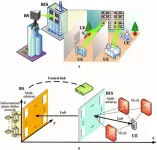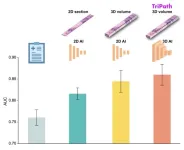(Press-News.org) UNIVERSITY PARK, Pa. — The Canadian wildfires of June 2023 exposed a large portion of the Northeastern United States to unprecedented levels of smoke. A new model that combines wildfire smoke forecasts and data from ground-based sensors may help public health officials plan targeted interventions in areas most at risk for the negative health effects of unexpected smoke events and air pollution, according to a team led by Penn State scientists.
The researchers reported their findings in the journal Science of the Total Environment.
“Statistical analyses suggest that situations like last year’s Canadian wildfires, where smoke travels long distances to affect the Eastern United States, may become the norm,” said lead author Manzhu Yu, assistant professor of geography at Penn State. “Our research can help public health officials in urban and rural areas plan targeted interventions for communities at higher risk of harmful air pollution during wildfire smoke events.”
The researchers focused on the periods between June 6-8 and June 28-30, 2023, when weather conditions and a coastal storm pushed large amounts of smoke from Canada into the Northeastern United States. They used data from ground-based sensors and a form of artificial intelligence called deep learning to improve a weather forecasting model from the National Center for Atmospheric Research. The model — the Weather Research and Forecasting model with Chemistry, or WRF-Chem — provides hourly data on surface concentrations of fine particulate matter (PM 2.5). Found in wildfire smoke and other forms of air pollution, these tiny particles can reach the lungs and cause health issues.
The scientists also studied anonymized mobility data from devices like smartphones to see how people changed their travel activities during the smoke events. Additionally, they conducted an environmental justice assessment using data from the U.S. Environmental Protection Agency to see if certain environmental and demographic factors correlated to increased vulnerability to negative health outcomes from wildfire smoke. These factors included variables like percentage of the population with less than a high school education, minority status, heart attack and asthma hospitalization rates, and existing pollution burdens from sources like heavy traffic and power plants. They studied these factors at the county level, from Pennsylvania and New Jersey up through Maine, to see if certain communities shared a larger part of the pollution burden than others.
The team found that the refined forecasting model better estimated the magnitude and timing of PM 2.5 spikes, measured in micrograms per cubic meter of air (µg/m3), across the study area than the current forecasting model. When looking at how predicted data matches observed data, with 0 µg/m3 of PM 2.5 signifying that the model exactly matches ground observations, the current forecasting model scored a -6.872 µg/m3, marking a large underestimation of particulate levels. The refined model scored a 0.160 µg/m3, marking a slight overestimation of particulate levels that aligned much closer to what the ground sensors measured. In addition, the researchers found that urban and rural communities already burdened by existing environmental pollution face higher air pollution levels during unexpected smoke events than other areas.
“The good news, according to our findings, is that when people hear about wildfire smoke, they tend to reduce their mobility,” Yu said. “But we found that during these smoke events New York City, Philadelphia and the surrounding counties still showed high mobility activities. We probably need to think about targeted interventions in urban areas because with so many people living in the area, exposure rates to unhealthy air are very high.”
Rural communities burdened by pollution from power plants and mines may have particular needs as well, she said. For example, she explained, Bennington County, Vermont, has few demographic factors that would make it more vulnerable to environmental pollution. However, it is home to multiple mines, heavy traffic, hazardous waste storage sites and more, which all contribute to higher environmental pollution scores. Those factors amplified air pollution levels during the smoky days.
“Public health interventions are usually based on population concentrations, which are naturally higher in urban areas,” Yu said. “Knowing these existing vulnerabilities in rural areas can help officials better serve these areas and protect the public’s health.”
In the meantime, individuals can take steps now to protect their health during the upcoming wildfire season.
“I would suggest that individuals have an air filter and indoor air pollution monitor in their homes,” Yu said. “They can also enhance the insulation around their windows and doors if smoke levels are really high. I would recommend working from home if possible or getting a high-quality mask if you have to travel outdoors. And I think in Pennsylvania, we need to talk about standards for organizations for how we respond to smoke days, whether that’s working from home, having a day off or dismissing early. We’re not used to smoke events, and we need some sort of policy or standard for protecting the public’s health.”
In addition to Yu, contributors to this research from Penn State include Zhenlong Li, associate professor of geography, and doctoral students Shiyan Zhang and Huan Ning; and Kai Zhang, Empire Innovation Associate Professor at the University of Albany’s School of Public Health.
Penn State, through the Miller Faculty Fellow Award from the College of Earth and Mineral Sciences, supported this research.
END
Improved wildfire smoke model identifies areas for public health intervention
2024-05-09
ELSE PRESS RELEASES FROM THIS DATE:
Highly drug-resistant infections from stem cell treatments in Mexico identified by National Jewish Health
2024-05-09
DENVER (May 9, 2024) – Experts in mycobacterial diseases at National Jewish Health, in collaboration with local health departments and the Centers for Disease Control and Prevention (CDC), are investigating a potential outbreak of a highly drug-resistant mycobacterium (germ) after U.S. patients who traveled to Mexico for stem cell injections became sick. Genetically identical Mycobacterium abscessus subspecies massiliense infections following stem cell injections at various clinics in Mexico prompted this investigation. Early results of the study were ...
Causal inference about the effects of interventions from observational studies in medical journals
2024-05-09
About The Study: Adoption of the proposed framework to identify when causal interpretation is appropriate in observational studies promises to facilitate better communication between authors, reviewers, editors, and readers. Practical implementation will require cooperation between editors, authors, and reviewers to operationalize the framework and evaluate its effect on the reporting of empirical research.
Corresponding Author: To contact the corresponding author, Issa J. Dahabreh, M.D., Sc.D., email idahabreh@hsph.harvard.edu.
To ...
Turning trash into treasure: breakthrough innovations in PET plastic upcycling
2024-05-09
A recent review has unveiled revolutionary methods to recycle and transform everyday polyethylene terephthalate (PET) plastic into valuable materials. By harnessing cutting-edge enzymes and catalysts, the review dramatically improves how we break down and reuse PET, slashing energy use and emissions. These game-changing techniques are poised to redefine plastic waste management and boost the circular economy.
Polyethylene terephthalate (PET) plastic into valuable materials. By harnessing cutting-edge PET, a prevalent form of plastic, poses significant environmental risks due to its durability and resistance to natural degradation. Traditional recycling methods often result in inferior-quality ...
Keck Medicine of USC launches institute to promote excellence in nursing
2024-05-09
LOS ANGELES — Keck Medicine of USC has launched the USC Nursing Institute to promote education, leadership development, clinical expertise and research among nurses.
The institute will support nurses across the health system’s four hospitals and more than 100 clinic locations to ensure nurses have access to the tools, education and training to provide exceptional patient care, facilitate collaboration and encourage career growth and leadership opportunities.
“Nurses are the backbone of our health system. The USC Nursing Institute supports a culture of excellence where nurses feel empowered to expand ...
Deep learning empowers reconfigurable intelligent surface in terahertz communication
2024-05-09
The escalating demand for wireless data traffic, driven by the proliferation of internet-of-things devices and broadband multimedia applications, has intensified the search for innovative solutions in wireless communication. A significant breakthrough has been reported in the application of reconfigurable intelligent surfaces for terahertz communications. In a research article published on Mar. 13 in Intelligent Computing, a team of researchers led by Zhen Gao of Beijing Institute of Technology has introduced a novel physical signal processing method that leverages deep learning to enhance ...
Scientists pinpoint new vaccine “booster” that promotes potent anti-tumour immunity
2024-05-09
Scientists from Trinity College Dublin have made an important breakthrough that offers promise for developing new immune therapies for cancer. They have discovered that a vaccine adjuvant – or “booster” – called C100 promotes potent anti-tumour immunity when it is injected directly into tumours in an animal model.
The scientists found that C100, derived from chitin – one of the most common building materials in nature, and which gives strength to the exoskeletons of crustaceans, insects, and the cell walls of fungi – is highly effective at stimulating a key sensing and signalling molecule which regulates ...
Study finds patients with limited English proficiency have poorer experiences with virtual health care
2024-05-09
People with limited English proficiency have a worse experience with virtual healthcare visits than those who are proficient in English, according to a new study led by a team of investigators at Brigham and Women’s Hospital, a founding member of the Mass General Brigham healthcare system. The study highlights the importance of designing telehealth platforms and processes that better serve people who face day-to-day language barriers.
The study, published in JAMA Network Open, analyzed results ...
Declination of treatment, racial and ethnic disparity, and overall survival in patients with breast cancer
2024-05-09
About The Study: This cross-sectional study highlights racial and ethnic disparities in treatment declination and overall survival, suggesting the need for equity-focused interventions, such as patient education on treatment benefits and improved patient-clinician communication and shared decision-making, to reduce disparities and improve patient survival.
Corresponding Author: To contact the corresponding author, Dezheng Huo, M.D., Ph.D., email dhuo@bsd.uchicago.edu.
To ...
Place-based measures of inequity and vision difficulty and blindness
2024-05-09
About The Study: Residential measures of inequity through segregation, income inequality, or persistent poverty were associated with a greater number of residents living with vision difficulty and blindness in this cross-sectional study. It is essential to understand and address how neighborhood characteristics can impact rates of vision difficulty and blindness.
Corresponding Author: To contact the corresponding author, Patrice M. Hicks, Ph.D., M.P.H., email pmhicks@med.umich.edu.
To access the embargoed study: Visit our For The Media website at this link https://media.jamanetwork.com/
(doi:10.1001/jamaophthalmol.2024.1207)
Editor’s ...
AI advancements make the leap into 3D pathology possible
2024-05-09
Researchers developed Tripath to bridge computational gaps to process 3D tissue and predict outcomes based on 3D morphological features
Cancer recurrence models trained on 3D tissue volumes outperformed models trained on 2D tissue images
Human tissue is intricate, complex and, of course, three dimensional. But the thin slices of tissue that pathologists most often use to diagnose disease are two dimensional, offering only a limited glimpse at the tissue’s true complexity. There is a growing push in the field of pathology toward examining tissue in its three-dimensional form. But 3D pathology datasets can contain hundreds of times more data than their 2D counterparts, ...



